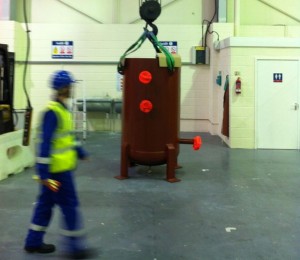It was three years ago, standing in the middle of my first Big Rig structure that I first had the idea of getting engineering students to build their own nuclear reactor. Today I watched as a group of students lifted their ‘reactor’ into position on day two of the pilot of Nuclear Island Big Rig.
The Big Rig lends itself well to creating mock-ups of industrial plant and installations. The design and construction of a nuclear power station, with some significant alterations for practicality, is exactly the sort of exciting-sounding brief that we use at Think Up to inspire people to pursue a career in engineering.
The opportunity to put this idea into practice came when Think Up was approached by Cogent to design an event to inspire electrical, mechanical and chemical engineers to take up a career in the nuclear new-build sector. The result is Nuclear Island Big Rig, a week-long event in which a group of 16 engineering undergraduates and apprentices are challenged to assemble, operate, and dismantle a mock-up of the primary cooling circuit of a PWR.
I was not able to facilitate this event because of my paternity leave, but today I went down for the day to see how everyone is getting on. There I found a team of well motivated students working their way through the problems they were encountering. Some of the most the undergraduates – I had the impression they had a lot to learn from each other.
While I am not there all week, some of the features we are building into the event are making it easier for us to connect with learners directly from our head office. For instance, we are using our Student Studio online platform to host personal reflective blogs and a student forum for the event. We can use this tool to track the event remotely, and to gather lie feedback as the event progresses. Similarly we created a Facebook event page, which has already enabled us to connect more easily with participants, and allowed them to share practical information with one another.
I am looking forward to hearing how the students get on over the rest of the week, and to seeing how we can improve the event over future iterations based on what we have learned.



Leave a Reply